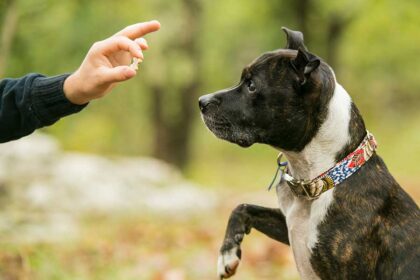Training a dog is more than just a process of teaching commands—it’s an art of communication. It’s how people and their pets learn to understand one another, creating harmony in the home and confidence in the outside world. Whether you’ve just welcomed a playful puppy or are helping an adult dog develop new skills, training is the bridge that connects two species through patience, trust, and consistency.
Many new pet owners are surprised to learn that training isn’t just about obedience. It’s also about emotional growth. When we teach a dog to “sit,” “stay,” or “come,” we’re not just shaping behavior—we’re helping them feel secure in their place in the world. Dogs crave structure, and gentle, consistent training provides exactly that.
Training as a Language
Training is often described as a conversation. You speak through tone, timing, and movement; your dog replies with attention, tail wags, and body posture. Over time, this communication develops into a shared understanding. Each small success builds trust, and each repetition reinforces connection.
In structured dog and puppy training classes, the emphasis is on positive communication rather than control. The goal isn’t to dominate but to guide. Dogs respond best when they feel respected and safe. This mutual respect forms the heart of effective training—an unspoken agreement that says, “We’re learning together.”
Why Early Training Matters
A puppy’s first few months are crucial for shaping lifelong habits. During this stage, their brain is like a sponge, absorbing information about how to interact with people, animals, and their environment. Proper training at this age can prevent future behavioral issues such as excessive barking, jumping, or leash pulling.
But early training isn’t just for the dog—it benefits the owner, too. It teaches patience, observation, and empathy. Puppies will make mistakes, test limits, and sometimes forget what they’ve learned. Responding calmly in these moments helps create a learning environment built on encouragement rather than frustration.
Adult dogs, too, can benefit from learning or relearning basic manners. With the right approach, even an older dog can adapt beautifully. The secret lies in consistency and kindness.
The Role of Routine
One of the strongest tools in dog training is routine. Dogs thrive when they know what to expect. Regular feeding, walking, and play schedules provide stability that supports learning. When training becomes part of that rhythm, dogs anticipate their lessons with excitement instead of stress.
For example, practicing commands during daily walks or mealtime creates natural opportunities to reinforce behavior. When a dog consistently receives the same cues and rewards in familiar settings, the training becomes second nature. The dog isn’t just obeying commands—they’re participating in a pattern that makes them feel confident and secure.
Positive Reinforcement Works Best
Modern trainers agree: punishment-based methods don’t build trust. Instead, reward-based training—using praise, treats, or play—encourages dogs to repeat good behavior. Rewards help dogs associate commands with positive outcomes. Over time, they begin to work not just for treats but for the joy of pleasing their humans.
The beauty of positive reinforcement lies in how it strengthens the relationship between dog and owner. It creates moments of joy, mutual understanding, and progress. Every successful response becomes a small victory celebrated by both sides.
Socialization Through Training
Another benefit of organized training is socialization. In group settings, dogs learn to stay calm around distractions—other animals, people, and noises. These experiences are invaluable, especially for young dogs who might otherwise become nervous or overexcited in new environments.
Training alongside other dogs also teaches patience. Waiting for their turn, sharing space, and focusing amid activity all build emotional control. These skills make everyday outings—like park visits or walks—much easier and safer.
Reading Your Dog’s Emotions
A patient trainer observes as much as they teach. Dogs communicate through subtle cues: ear position, tail movement, and even breathing patterns. Recognizing signs of stress or confusion helps adjust training methods gently. If a dog becomes tense or distracted, it’s better to pause and reset than to push harder.
Training works best when it’s joyful. Turning lessons into games—like hide-and-seek, fetch with commands, or simple puzzles—keeps dogs mentally stimulated and eager to learn. A dog who enjoys training is a dog who will keep improving.
Consistency Beyond the Class
Training doesn’t end when formal sessions do. The lessons learned must carry over into daily life. This is where many owners see real transformation—when their dog sits calmly before meals, waits at doorways, or comes running when called. These behaviors become habits through everyday repetition and reinforcement.
The success of any training program depends less on the dog’s intelligence and more on the owner’s commitment. Dogs want to please, but they need clarity and patience from their humans. When you stay consistent, they follow your lead with trust.
A Journey of Mutual Growth
Dog training is not a one-way street. It teaches humans as much as it teaches animals. It helps people slow down, observe, and develop empathy for another species. Through training, owners learn the power of tone, timing, and calm energy.
The process also builds resilience. When progress feels slow, both dog and trainer learn to keep going—to trust that small efforts lead to big results. The patience learned through training often spills into other areas of life, reminding us that growth, whether human or canine, takes time.
Final Thoughts
Every well-behaved dog reflects hours of patient teaching, consistent practice, and genuine care. Training strengthens not just obedience but the emotional bond between human and dog. The connection formed through this shared experience lasts a lifetime—a quiet understanding that words could never replace.
Whether you train at home, in the park, or in group settings, what matters most is that you and your dog grow together. Training isn’t a chore—it’s a celebration of companionship, communication, and unconditional love.

